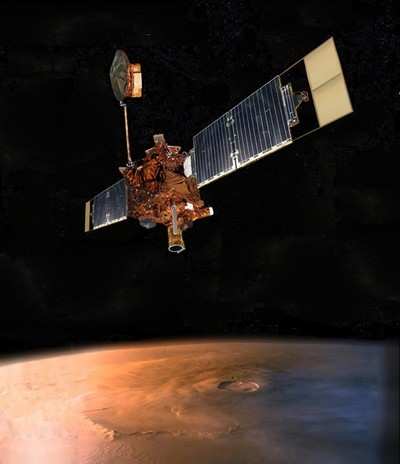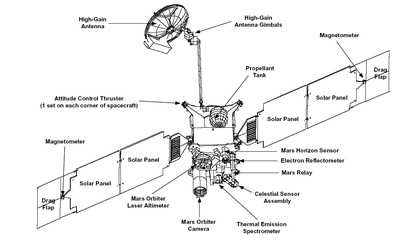Agency Unlikely To File Warranty Claim, Though
They just don't build 'em like they used to. After studying Mars
-- for, it must be noted, four times longer than originally planned
-- NASA's Mars Global Surveyor orbiter appears to have succumbed to
battery failure in early November 2006, caused by a complex
sequence of events involving the onboard computer memory and ground
commands.

The causes were released this week in a preliminary report by an
internal NASA review board. The board was formed to look more
in-depth into why NASA's Mars Global Surveyor went silent, and to
recommend any processes or procedures that could increase safety
for other spacecraft.
As Aero-News reported, Mars
Global Surveyor last communicated with Earth on November 2, 2006.
The agency believes that within 11 hours, depleted batteries left
the spacecraft unable to control its orientation.
"The loss of the spacecraft was the result of a series of events
linked to a computer error made five months before the likely
battery failure," said board Chairperson Dolly Perkins, deputy
director-technical of NASA Goddard Space Flight Center, Greenbelt,
Md.
The Board found the chain of events leading to the failure of
the MGS as follows. After NASA ordered the Mars Global Surveyor to
perform a routine adjustment of its solar panels, the spacecraft
reported a series of alarms, but indicated that it had
stabilized.
That was its final transmission. Subsequently, the spacecraft
reoriented to an angle that exposed one of two batteries carried on
the spacecraft to direct sunlight. This caused the battery to
overheat and ultimately led to the depletion of both batteries.
Incorrect antenna pointing prevented the orbiter from telling
controllers its status, and its programmed safety response did not
include making sure the spacecraft orientation was thermally
safe.
The board also concluded the Mars Global Surveyor team followed
existing procedures, but that procedures were insufficient to catch
the errors that occurred -- easing the sting somewhat from earlier accusations
human error had doomed the orbiter.
The board is finalizing recommendations to apply to other
missions, such as conducting more thorough reviews of all
non-routine changes to stored data before they are uploaded and to
evaluate spacecraft contingency modes for risks of overheating.
"We are making an end-to-end review of all our missions to be
sure that we apply the lessons learned from Mars Global Surveyor to
all our ongoing missions," said Fuk Li, Mars Exploration Program
manager at NASA's Jet Propulsion Laboratory, Pasadena, CA.
Mars Global Surveyor, launched in 1996, operated longer at Mars
than any other spacecraft in history, and for more than four times
as long as the prime mission originally planned. NASA states the
spacecraft returned detailed information that has overhauled
understanding about Mars. Major findings include dramatic evidence
that water still flows in short bursts down hillside gullies, and
identification of deposits of water-related minerals leading to
selection of a Mars rover landing site.

Incidentally... NASA's two Mars rovers, Spirit and Opportunity,
continue to plug along on the Martian surface, too. Both are moving
a bit slower than when they were new, perhaps, but both rovers are
still functioning, far surpassing the agency's best hopes.
Maybe it's something in the vacuum...
 SpaceX to Launch Inversion RAY Reentry Vehicle in Fall
SpaceX to Launch Inversion RAY Reentry Vehicle in Fall Aero-News: Quote of the Day (04.23.24)
Aero-News: Quote of the Day (04.23.24) Aero-News: Quote of the Day (04.20.24)
Aero-News: Quote of the Day (04.20.24) ANN's Daily Aero-Linx (04.20.24)
ANN's Daily Aero-Linx (04.20.24) Aero-News: Quote of the Day (04.21.24)
Aero-News: Quote of the Day (04.21.24)




